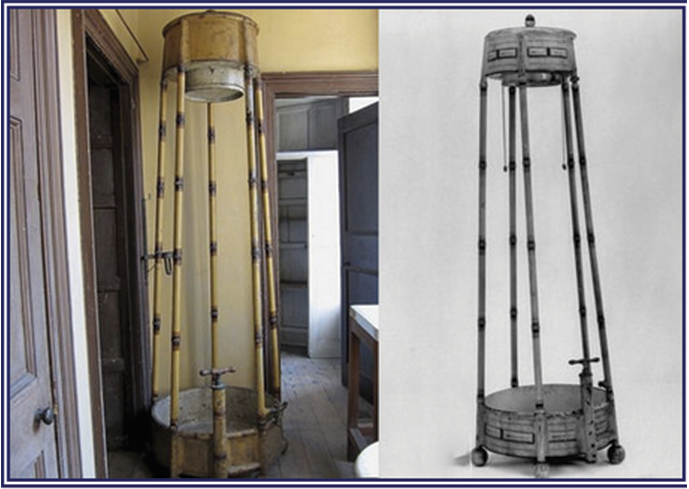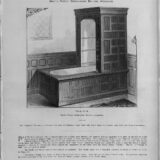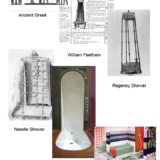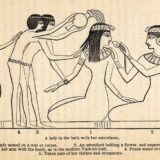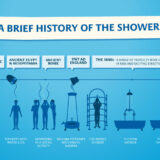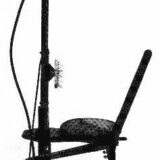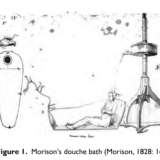The shower. Ahhhhh. So relaxing, if you close your eyes it feels like lazing under your own personal warm waterfall (after all, wanting an on-demand personal waterfall was why the ancients invented showers). With relaxation like that, it’s no surprise that the shower is where 78 percent of Americans claim to do their deepest thinking. But what do you really know about showers, the place the average American will spend about 5 months of their life? Below, we listed some of the unlikely and strange story of how the shower ended up in every home: it involves early mental institutions, prisons, and probably a lot of lead poisoning. (First, though, let us interrupt for a second to say: since you do spend so much time in the bathroom, it might not be a bad idea consider looking into our very affordable refinishing services).
The first shower of the modern age was patented in 1767 by a London stove-maker. It’s design? Literally, you stand under a bucket of water and pull a rope. Even still, the idea of the shower didn’t exist in the public imagination, there wasn’t even a set name for it. For a long time, at least in Europe, instead of a shower you took Rain Baths (“bain de pluie,” in French), and later shampoo baths. It was seen as a novelty, and it took until the late 1800s for the idea to catch on. But big things have humble beginnings: but not the first patented shower design. The first real modern shower, the English Regency Shower— a 12-foot tall contraption that caught and recycled water– began to appear in wealthy households after 1810. A picture of one is at the top of this post.
The first shower taken in America happened most likely in 1829 at the Tremont Hotel of Boston, where Isaiah Rogers built group basement showers and installed eight private ‘water closets” on the first floor, so lodgers would no longer need resort to chamber pots or outhouses.
It took until 1833 for the white house to get indoor plumbing and bathing— but no showers yet— and only on the first floor. As for the word “plumbing” itself”– It literally means ‘lead” in Latin. The Romans made their water pipes out of “plumbum” or lead, and an expert who maintained the pipes was a “Plumbarius.” After Rome fell in the 5th century, knowledge of plumbing fell away: it would be a thousand years before even the rich could enjoy indoor plumbing, baths and showers.
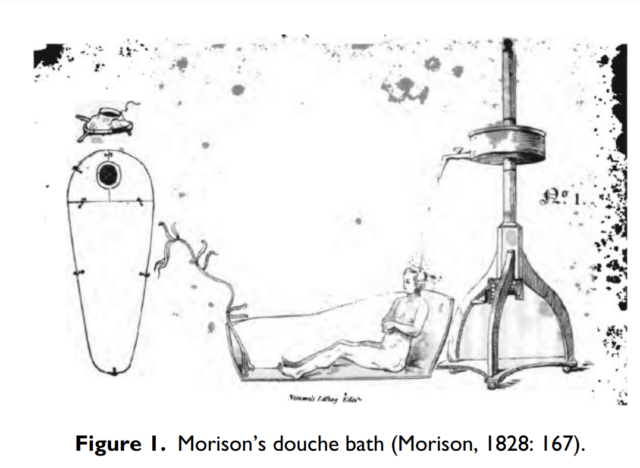
It took the re-invention of sophisticated plumbing bringing running water to the masses, around 1850, for showers to really have the chance to start catching on. Plumbing, and the 1800s explosion of health and hygiene knowledge in the mid-to late 1800s, American averaged wash increased form one every few weeks to several times every week.
Before running water, showering saw its first widespread use in mental institutions and, later, jails. Psychology as a field hadn’t been invented yet: compared to physical medicine, mental illness was still almost totally misunderstood. Called rain baths at the time, in the late 1700s to late 1800s leading doctors routinely treated patients by dumping cold water on their heads. The theory was that it would cool down their over-heated brains, thus curing them.
Dr. François Merry Delabost, a French Colonel, revived the shower in 1873, invented and installed group showers to improve hygiene and health among the inmates in Rouen prison. Later, he’d implement the same idea in the military.
Still, showering in began to finally catch on in the late 1800s, at least in urban areas. Mostly, it was by necessity: imagine the spread of germs in a tenement apartment building with no running water. But, overall, the vast majority of Americans still had only a bath, with no shower. It would take until the 1950s before showers became a standard inclusion in building new homes.
Until the 18th century, in most homes, the idea of shower and toilet sharing the same room would have probably disgusted– or at least confused— the whole household. It’s still unusual in some places, Germany for example, for a toilet and shower/bath to share the same room. The bathroom came first– a room to bathe in, with or without running water. Other business was done in the bedroom in chamber pots or, in America more than Europe, outhouses. When plumbing arrived around 1850, the toilet had to be hidden somewhere; usually it was a converted closet– thus “water closet.” Baths, however, still meant grabbing the wooden tub from its storage spot and filling it up with water heated over the stove. It was normal for the whole family to take turns, each using the same water.
One of the first American-invented showers, the “Virginia Stool Shower,” as it’s now called, looks more like a piece of gym equipment than a shower. Well, it did give the user a workout just operating it: a hand-lever pumped water while a foot-lever rotated the seat and activated the automatic scrub brush.
Bathing was big in the ancient world– Greeks, Egyptians, Romans, China . . . but the first shower ever taken happened long before those civilizations: today we call them waterfalls. Likely, ancient bathers wanted to find some way to make waterfall on command. The Egyptians “shower” was as simple as one of the elite making his or her servants repeatedly pour jugs of water over his or her head. For a longer history, see below.
From Visually.

